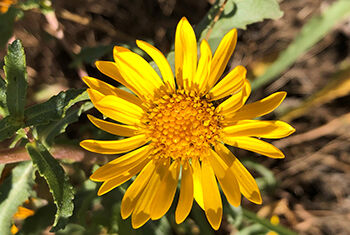Wildfires are a major problem in the Intermountain West, affecting thousands of acres of rangelands and destroying wildlife habitat, livestock grazing lands, and costing millions of dollars every year.
One tool used by land managers to hinder the spread of rangeland wildfire and reduce its impact is the implementation of carefully placed fuel breaks. Fuel breaks, when designed correctly, can compartmentalize wildfires, allowing fire crews time to respond. A subset of fuel break is the greenstrip wherein plants with beneficial fire-suppressing attributes are strategically installed in locations where they might slow the advancement of a wildfire.
Curlycup gumweed, a native forb, shows excellent fire resistance qualities making it a novel candidate for inclusion in western greenstrips.Several attributes are desirable for greenstrip plantings. Plants should: 1) stay green and retain high moisture content during the wildfire season, 2) be adapted to the site and have the ability to persist through periodic extended drought conditions, 3) tolerate grazing, 4) reduce fuel load and continuity by producing low amounts of fuel and/or having widely separated individual plants, 5) be capable of establishing and persisting among competitive annual species, and 6) be fire tolerant.
While there are many “fire-wise" plant species recommendations for urban landscaping, these are often not suited for large scale seeded greenstrips. Many fire-wise recommended species require irrigation to stay green and survive, and many more are non-native species that are inappropriate for native ecosystems.
Very few species have been shown to possess all the above-mentioned desired attributes. Because of the limited number of suitable species, greenstrips are often monocultures of non-native perennials such as crested wheatgrass or forage kochia which offer little to native wildlife and hamper ecosystem function. More quantitative information is needed on the burning attributes of commonly occurring rangeland species to help develop a broader suite of science-based greenstrip recommendations. One trait to assess potential flammability risk is moisture content. Last summer, the Aberdeen Plant Materials Center in Idaho measured moisture content in leaf and stem samples of 15 common Great Basin species throughout the critical summer period from June to September.
Curlycup gumweed offers good fire suppression capabilities while also providing food for native pollinators and other wildlife.By comparing plant moisture content over the course of the summer, it is possible to develop quantitative recommendations. Moisture content changes significantly from early to late summer. Exotic annuals like cheatgrass, begin the season with high moisture content but drastically lose moisture later in the season resulting in extremely high fire risk. Species that retain high moisture content throughout the fire season like forage kochia and Russian wildrye are those best adapted for use in greenstrips. However, forage kochia and Russian wildrye are not native to the United States so may not be the most appropriate species in all situations. The Aberdeen Plant Materials Center study revealed that the native wildflower, curlycup gumweed, had better traits for fire suppression and resistance than many of the most used species. This information is being used to update technical notes and practice standards in the west.
USDA NRCS Plant Materials Centers in the west are continuing to evaluate additional native species, some of which will be developed into conservation plants released to the public. This valuable work will afford landowners and managers with more options and better tools to combat rangeland wildfires while providing ecosystem functions for native wildlife.
For additional information on specific species of plants mentioned, please see the USDA PLANTS database. Technical information and guidance regarding plants for wildfire protection and restoration is available on the Plant Materials Program website or contact the nearest Plant Materials Center or plant materials specialist.



